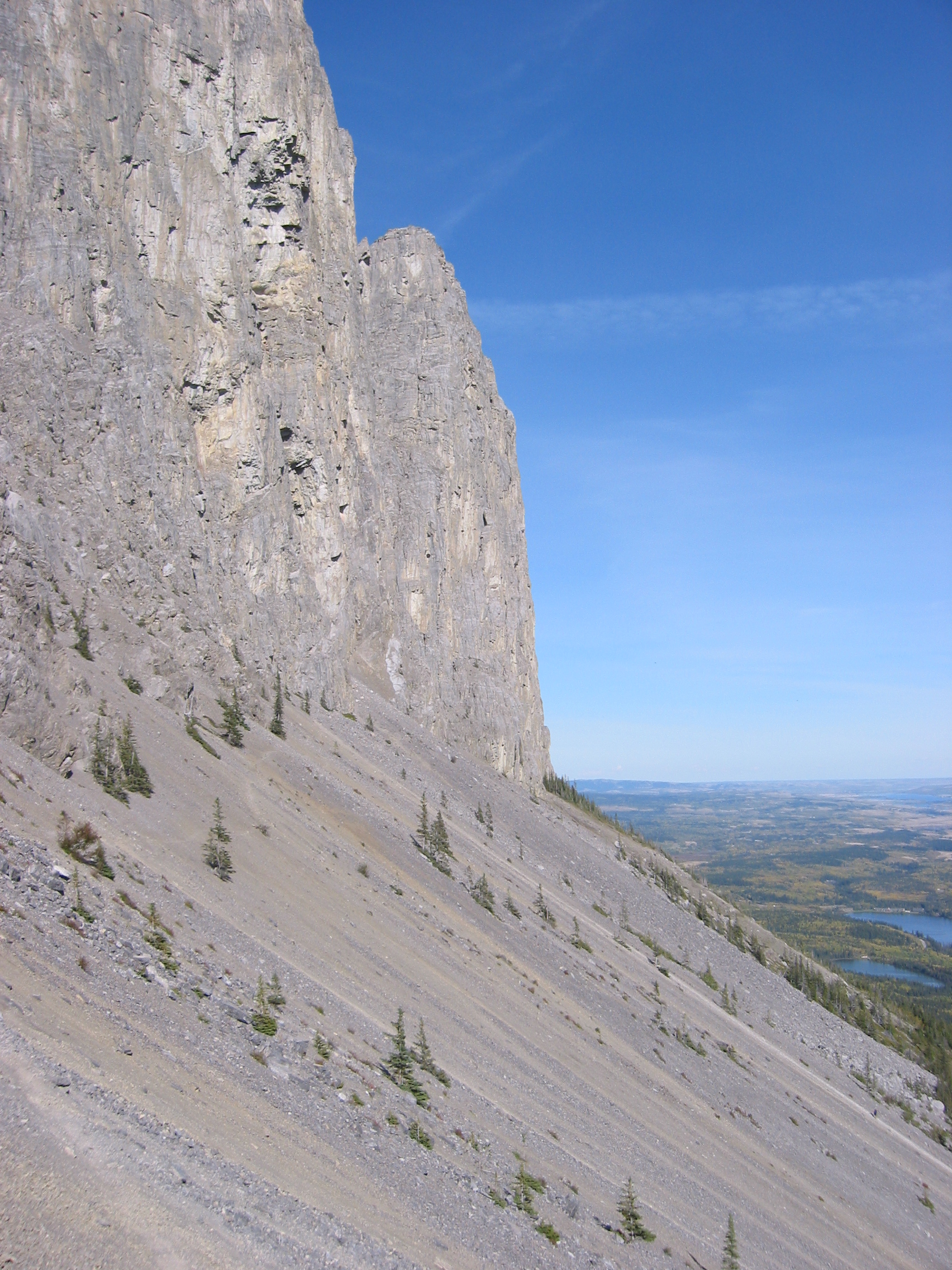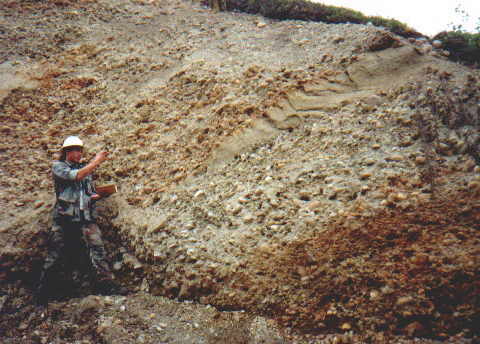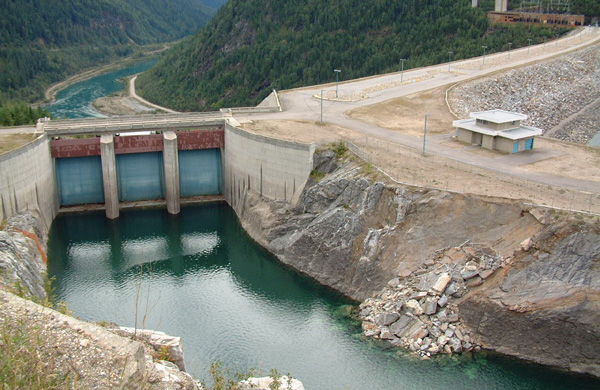|
Colluvium
Colluvium (also colluvial material or colluvial soil) is a general name for loose, unconsolidated sediments that have been deposited at the base of hillslopes by either rainwash, sheetwash, slow continuous downslope creep, or a variable combination of these processes. Colluvium is typically composed of a heterogeneous range of rock types and sediments ranging from silt to rock fragments of various sizes. This term is also used to specifically refer to sediment deposited at the base of a hillslope by unconcentrated surface runoff or sheet erosion. Location Colluviation refers to the buildup of colluvium at the base of a hillslope.Jackson, JA, J Mehl, and K. Neuendorf (2005) ''Glossary of Geology'' American Geological Institute, Alexandria, Virginia. 800 pp. Goodie, AS (2003) ''Colluvium'' in A. S. Goodie, ed., pp. 173, Encyclopedia of Geomorphology Volume 1, A–I. Routledge, New York, New York. 1200 pp. Colluvium is typically loosely consolidated angular material located at th ... [...More Info...] [...Related Items...] OR: [Wikipedia] [Google] [Baidu] |
Scree
Scree is a collection of broken rock fragments at the base of a cliff or other steep rocky mass that has accumulated through periodic rockfall. Landforms associated with these materials are often called talus deposits. Talus deposits typically have a concave upwards form, where the maximum inclination corresponds to the angle of repose of the mean debris particle size. The exact definition of scree in the primary literature is somewhat relaxed, and it often overlaps with both ''talus'' and ''colluvium''. The term ''scree'' comes from the Old Norse term for landslide, ''skriða'', while the term ''talus'' is a French word meaning a slope or embankment. In high-altitude arctic and subarctic regions, scree slopes and talus deposits are typically adjacent to hills and river valleys. These steep slopes usually originate from late-Pleistocene periglacial processes. Notable scree sites in Eastern North America include the Ice Caves at White Rocks National Recreation Area in southern Ve ... [...More Info...] [...Related Items...] OR: [Wikipedia] [Google] [Baidu] |
Alluvium
Alluvium (from Latin ''alluvius'', from ''alluere'' 'to wash against') is loose clay, silt, sand, or gravel that has been deposited by running water in a stream bed, on a floodplain, in an alluvial fan or beach, or in similar settings. Alluvium is also sometimes called alluvial deposit. Alluvium is typically geologically young and is not consolidated into solid rock. Sediments deposited underwater, in seas, estuaries, lakes, or ponds, are not described as alluvium. Floodplain alluvium can be highly fertile, and supported some of the earliest human civilizations. Definitions The present consensus is that "alluvium" refers to loose sediments of all types deposited by running water in floodplains or in alluvial fans or related landforms. However, the meaning of the term has varied considerably since it was first defined in the French dictionary of Antoine Furetière, posthumously published in 1690. Drawing upon concepts from Roman law, Furetière defined ''alluvion'' (the F ... [...More Info...] [...Related Items...] OR: [Wikipedia] [Google] [Baidu] |
Colluvium-filled Bedrock Hollow
There have been known various classifications of landslides. Broad definitions include forms of mass movement (geology), mass movement that narrower definitions exclude. For example, the ''McGraw-Hill Encyclopedia of Science and Technology'' distinguishes the following types of landslides: *fall (by undercutting) *fall (by toppling) *Slump (geology), slump *rockslide *earthflow *sinkholes, mountain side *rockslide that develops into rock avalanche Influential narrower definitions restrict landslides to slumps and translational slides in rock and regolith, not involving fluidisation. This excludes falls, topples, lateral spreads, and mass flows from the definition.Varnes D. J., Slope movement types and processes. In: Schuster R. L. & Krizek R. J. Ed., Landslides, analysis and control. Transportation Research Board Sp. Rep. No. 176, Nat. Acad. oi Sciences, pp. 11–33, 1978.Hungr O, Evans SG, Bovis M, and Hutchinson JN (2001) Review of the classification of landslides of the flow type ... [...More Info...] [...Related Items...] OR: [Wikipedia] [Google] [Baidu] |
Diluvium
Diluvium is an archaic term applied during the 1800s to widespread surficial deposits of sediments that could not be explained by the historic action of rivers and seas. Diluvium was initially argued to have been deposited by the action of extraordinary floods of vast extent, specifically the Noachian Flood.Neuendorf, K.K.E., J.P. Mehl, Jr., and J.A. Jackson, eds. (2005) ''Glossary of Geology'' (5th ed.). Alexandria, Virginia, American Geological Institute. 779 pp. Kotlyakov, V. and Komarova, A., 2006. ''Elsevier's dictionary of geography: in English, Russian, French, Spanish and German.'' New York, Elsevier Scientific Publishing. 1072 pp. In 1822 and 1823, William Buckland published the term ''diluvium'' in his monograph ''Reliquiae Diluvianae ''Buckland, W., 1823. ''Reliquiae Diluvianae, or Observations on the Organic Remains Contained in Caves, Fissures, and Diluvial Gravel, and on Other Geological Phenomena, Attesting the Action of an Universal Deluge.'' 1st ed. John Murray ... [...More Info...] [...Related Items...] OR: [Wikipedia] [Google] [Baidu] |
Koster Site
The Koster Site is a prehistoric archaeological site located south of Eldred, Illinois. The site covers more than 3 acres and extends 30 feet down into the alluvial deposits of the Illinois River valley. Over the course of its excavation between 1969 and 1978, Koster produced deeply buried evidence of ancient human occupation from the early Archaic period (BC 7500) to the Mississippian period (AD 1000). The soil strata contains a total of 25 distinct occupations each separated by additional layers of soil, making the site exceptionally well-preserved. The site includes one of the oldest known cemetery sites in eastern North America. The cemetery site has provided researchers with evidence that Early Archaic civilizations had specific burial practices and buried their dead in mounds, often with numerous individuals buried together. Other significant discoveries made at the site include early evidence of North Americans using stones to grind food and keeping domesticated dogs. ... [...More Info...] [...Related Items...] OR: [Wikipedia] [Google] [Baidu] |
Illuvium
Illuvium is material displaced across a soil profile, from one layer to another one, by the action of rainwater. The removal of material from a soil layer is called eluviation. The transport of the material may be either mechanical or chemical. The process of deposition of illuvium is termed illuviation. It is a water-assisted transport in a basically vertical direction, as compared to alluviation, the horizontal running water transfer. The resulting deposits are called illuvial deposits. Cutans are a type of illuvial deposit. Illuvium includes organic matter, silicate clay, and hydrous oxides of iron and aluminum. Illuvial deposits of clays, oxides, and organics accumulate in subsoil as distinctive soil horizons classified as "B horizons" or "zones of illuviation". Mechanical illuviation When percolating rain water reaches a drier soil horizon, water from the suspension is removed by capillary action of microchannels, leaving fine deposits (cutans) oriented along percolat ... [...More Info...] [...Related Items...] OR: [Wikipedia] [Google] [Baidu] |
Erosion
Erosion is the action of surface processes (such as water flow or wind) that removes soil, rock, or dissolved material from one location on the Earth's crust, and then transports it to another location where it is deposited. Erosion is distinct from weathering which involves no movement. Removal of rock or soil as clastic sediment is referred to as ''physical'' or ''mechanical'' erosion; this contrasts with ''chemical'' erosion, where soil or rock material is removed from an area by dissolution. Eroded sediment or solutes may be transported just a few millimetres, or for thousands of kilometres. Agents of erosion include rainfall; bedrock wear in rivers; coastal erosion by the sea and waves; glacial plucking, abrasion, and scour; areal flooding; wind abrasion; groundwater processes; and mass movement processes in steep landscapes like landslides and debris flows. The rates at which such processes act control how fast a surface is eroded. Typically, physical ... [...More Info...] [...Related Items...] OR: [Wikipedia] [Google] [Baidu] |
Eluvium
In geology, eluvium or eluvial deposits are those geological deposits and soils that are derived by ''in situ'' weathering or weathering plus gravitational movement or accumulation. The process of removal of materials from geological or soil horizons is called eluviation or leaching. There is a difference in the usage of this term in geology and soil science. In soil science, eluviation is the transport of soil material from upper layers of soil to lower levels by downward percolation of water across soil horizons, and accumulation of this material ( illuvial deposit) in lower levels is called illuviation. In geology, the removed material is irrelevant, and the deposit (eluvial deposit) is the remaining material. Eluviation occurs when precipitation exceeds evaporation. A soil horizon formed due to eluviation is an eluvial zone or eluvial horizon. In a typical soil profile, the eluvial horizon refers to a light-colored zone located (depending on context and literature) either at th ... [...More Info...] [...Related Items...] OR: [Wikipedia] [Google] [Baidu] |
Entrainment (physical Geography)
In physical geography, entrainment is the process by which surface sediment is incorporated into a fluid flow (such as air, water or even ice) as part of the operation of erosion Erosion is the action of surface processes (such as water flow or wind) that removes soil, rock, or dissolved material from one location on the Earth's crust, and then transports it to another location where it is deposited. Erosion is di ....Thomas,D.S.G. and Goudie, A. (Eds.), ''The Dictionary of Physical Geography'' (3rd edition), Blackwell Publishers, Great Britain, 2000 References Physical geography {{geo-term-stub ... [...More Info...] [...Related Items...] OR: [Wikipedia] [Google] [Baidu] |
Geomorphology
Geomorphology (from Ancient Greek: , ', "earth"; , ', "form"; and , ', "study") is the scientific study of the origin and evolution of topographic and bathymetric features created by physical, chemical or biological processes operating at or near Earth's surface. Geomorphologists seek to understand why landscapes look the way they do, to understand landform and terrain history and dynamics and to predict changes through a combination of field observations, physical experiments and numerical modeling. Geomorphologists work within disciplines such as physical geography, geology, geodesy, engineering geology, archaeology, climatology, and geotechnical engineering. This broad base of interests contributes to many research styles and interests within the field. Overview Earth's surface is modified by a combination of surface processes that shape landscapes, and geologic processes that cause tectonic uplift and subsidence, and shape the coastal geography. Surface proc ... [...More Info...] [...Related Items...] OR: [Wikipedia] [Google] [Baidu] |
Glacier
A glacier (; ) is a persistent body of dense ice that is constantly moving under its own weight. A glacier forms where the accumulation of snow exceeds its ablation over many years, often centuries. It acquires distinguishing features, such as crevasses and seracs, as it slowly flows and deforms under stresses induced by its weight. As it moves, it abrades rock and debris from its substrate to create landforms such as cirques, moraines, or fjords. Although a glacier may flow into a body of water, it forms only on land and is distinct from the much thinner sea ice and lake ice that form on the surface of bodies of water. On Earth, 99% of glacial ice is contained within vast ice sheets (also known as "continental glaciers") in the polar regions, but glaciers may be found in mountain ranges on every continent other than the Australian mainland, including Oceania's high-latitude oceanic island countries such as New Zealand. Between latitudes 35°N and 35°S, glaciers occur ... [...More Info...] [...Related Items...] OR: [Wikipedia] [Google] [Baidu] |
Greene County, Illinois
Greene County is a county located in the U.S. state of Illinois. According to the 2020 United States Census, it has a population of 11,843. Its county seat is Carrollton. A notable archaeological area, the Koster Site, has produced evidence of more than 7,000 years of human habitation. Artifacts from the site are displayed at the Center for American Archeology in Kampsville, Illinois. History Greene County is named in honor of General Nathanael Greene, a hero of the American Revolutionary War. In 1821, three years after Illinois became a state, Greene County was established, being carved out of what was previously Madison county and St. Clair county before that. Over the course of the next 18 years four more counties were formed out of what was once Greene Country. These include Scott, Morgan, Macoupin and Jersey counties. This left Greene county with approximately 546 square miles of land located in western-central Illinois near the Illinois River, which was an important re ... [...More Info...] [...Related Items...] OR: [Wikipedia] [Google] [Baidu] |






